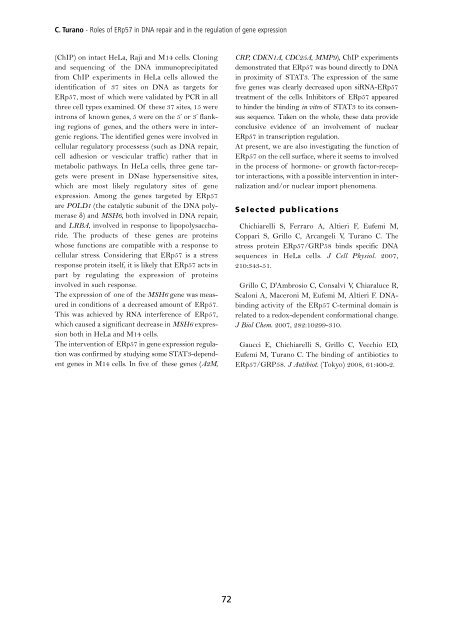download report - Istituto Pasteur
download report - Istituto Pasteur
download report - Istituto Pasteur
Create successful ePaper yourself
Turn your PDF publications into a flip-book with our unique Google optimized e-Paper software.
C. Turano - Roles of ERp57 in DNA repair and in the regulation of gene expression<br />
(ChIP) on intact HeLa, Raji and M14 cells. Cloning<br />
and sequencing of the DNA immunoprecipitated<br />
from ChIP experiments in HeLa cells allowed the<br />
identification of 37 sites on DNA as targets for<br />
ERp57, most of which were validated by PCR in all<br />
three cell types examined. Of these 37 sites, 15 were<br />
introns of known genes, 5 were on the 5’ or 3’ flanking<br />
regions of genes, and the others were in intergenic<br />
regions. The identified genes were involved in<br />
cellular regulatory processess (such as DNA repair,<br />
cell adhesion or vescicular traffic) rather that in<br />
metabolic pathways. In HeLa cells, three gene targets<br />
were present in DNase hypersensitive sites,<br />
which are most likely regulatory sites of gene<br />
expression. Among the genes targeted by ERp57<br />
are POLD1 (the catalytic subunit of the DNA polymerase<br />
δ) and MSH6, both involved in DNA repair,<br />
and LRBA, involved in response to lipopolysaccharide.<br />
The products of these genes are proteins<br />
whose functions are compatible with a response to<br />
cellular stress. Considering that ERp57 is a stress<br />
response protein itself, it is likely that ERp57 acts in<br />
part by regulating the expression of proteins<br />
involved in such response.<br />
The expression of one of the MSH6 gene was measured<br />
in conditions of a decreased amount of ERp57.<br />
This was achieved by RNA interference of ERp57,<br />
which caused a significant decrease in MSH6 expression<br />
both in HeLa and M14 cells.<br />
The intervention of ERp57 in gene expression regulation<br />
was confirmed by studying some STAT3-dependent<br />
genes in M14 cells. In five of these genes (A2M,<br />
72<br />
CRP, CDKN1A, CDC25A, MMP9), ChIP experiments<br />
demonstrated that ERp57 was bound directly to DNA<br />
in proximity of STAT3. The expression of the same<br />
five genes was clearly decreased upon siRNA-ERp57<br />
treatment of the cells. Inhibitors of ERp57 appeared<br />
to hinder the binding in vitro of STAT3 to its consensus<br />
sequence. Taken on the whole, these data provide<br />
conclusive evidence of an involvement of nuclear<br />
ERp57 in transcription regulation.<br />
At present, we are also investigating the function of<br />
ERp57 on the cell surface, where it seems to involved<br />
in the process of hormone- or growth factor-receptor<br />
interactions, with a possible intervention in internalization<br />
and/or nuclear import phenomena.<br />
Selected publications<br />
Chichiarelli S, Ferraro A, Altieri F, Eufemi M,<br />
Coppari S, Grillo C, Arcangeli V, Turano C. The<br />
stress protein ERp57/GRP58 binds specific DNA<br />
sequences in HeLa cells. J Cell Physiol. 2007,<br />
210:343-51.<br />
Grillo C, D'Ambrosio C, Consalvi V, Chiaraluce R,<br />
Scaloni A, Maceroni M, Eufemi M, Altieri F. DNAbinding<br />
activity of the ERp57 C-terminal domain is<br />
related to a redox-dependent conformational change.<br />
J Biol Chem. 2007, 282:10299-310.<br />
Gaucci E, Chichiarelli S, Grillo C, Vecchio ED,<br />
Eufemi M, Turano C. The binding of antibiotics to<br />
ERp57/GRP58. J Antibiot. (Tokyo) 2008, 61:400-2.








